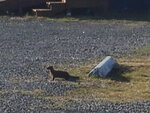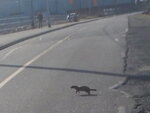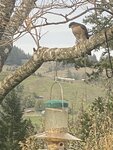Open main menu button
REMINDER: THE ARENA PLATFORM, INC. has no obligation to monitor the Forums. However, THE ARENA PLATFORM, INC. reserves the right to review any materials submitted to or posted on the Forums, and remove, delete, redact or otherwise modify such materials, in its sole discretion and for any reason whatsoever, at any time and from time to time, without notice or further obligation to you. THE ARENA PLATFORM, INC. has no obligation to display or post any materials provided by you. THE ARENA PLATFORM, INC. reserves the right to disclose, at any time and from time to time, any information or materials that we deem necessary or appropriate to satisfy any applicable law, regulation, contract obligation, legal or dispute process or government request. Click on the following hyperlinks to further read the applicable Privacy Policy and Terms of Use.
Official Bird & Nature Post
- Thread starter keenfish
- Start date
Birds aren’t realMass bird death in Mexico.
Had a neat little encounter with a local Mink this morning as I was finishing my daily walk on the Tyee Spit.
It popped out of the bush then stopped to check the traffic, which gave me enough time to fumble my camera from my pocket, turn it on and take a couple of shots.

Seconds after shooting this I heard the unmistakable barking of Oscar, a large Lab/Standard Poodle cross that belongs to Mike, as Oscar had spotted the Mink also, albeit from some distance.
Undeterred, the Mink quickly crossed the road and disappeared onto the beach, while Oscar did his very best wolf-like howl interspersed with loud barks. That's him and Mike on the sidewalk.

I was wearing Polaroids so when I looked through my viewfinder I literally couldn't see anything so shot blind in the general direction of the action. Surprised to get these, actually.
Take care.
It popped out of the bush then stopped to check the traffic, which gave me enough time to fumble my camera from my pocket, turn it on and take a couple of shots.

Seconds after shooting this I heard the unmistakable barking of Oscar, a large Lab/Standard Poodle cross that belongs to Mike, as Oscar had spotted the Mink also, albeit from some distance.
Undeterred, the Mink quickly crossed the road and disappeared onto the beach, while Oscar did his very best wolf-like howl interspersed with loud barks. That's him and Mike on the sidewalk.

I was wearing Polaroids so when I looked through my viewfinder I literally couldn't see anything so shot blind in the general direction of the action. Surprised to get these, actually.
Take care.
Did you take that? If so, hell of a shot. We have coyotes here, supposedly a lot of them. I've only seen them twice in the daytime and both times way out of camera range.
^ That's a Downy Woodpecker in case you were wondering.
Is that San Joaquin Wildlife Sanctuary? Look at mama's teets. Great shot!
Thanks! They are sneaky. Coyote population increases are proportional to human population due to food supply (cats and pets) plus their skill at avoiding humans. Indians call them "God's dog" due to their craftiness.Did you take that? If so, hell of a shot. We have coyotes here, supposedly a lot of them. I've only seen them twice in the daytime and both times way out of camera range.
Last edited:
Yes - SJWS. There's a lot of foot traffic there but if you're very quiet and very patient you will eventually see Bobcats. This day there was a duck with ducklings and coyote mom with pups. Ducks paid the tax!Is that San Joaquin Wildlife Sanctuary? Look at mama's teets. Great shot!
wrongCoyote population increases are proportional to human population due to food supply (cats and pets)
'Rodents make up the bulk of the coyote diet in both urban areas and rural areas. Although it has yet to be adequately measured in urban systems, experiments in rural areas have shown that the removal of coyotes results in a dramatic increase in rodent abundance and a decrease in rodent diversity (this means that only a few species increase and exclude other rodent species). Rodent increases have been observed in certain urban areas, such as golf courses, following coyote removal programs. There is also the possibility that coyotes help to control woodchucks. Many areas, including cemeteries and golf courses, have reported declines in woodchuck abundance once coyotes appeared.

Thank you for the correction.wrong
'Rodents make up the bulk of the coyote diet in both urban areas and rural areas. Although it has yet to be adequately measured in urban systems, experiments in rural areas have shown that the removal of coyotes results in a dramatic increase in rodent abundance and a decrease in rodent diversity (this means that only a few species increase and exclude other rodent species). Rodent increases have been observed in certain urban areas, such as golf courses, following coyote removal programs. There is also the possibility that coyotes help to control woodchucks. Many areas, including cemeteries and golf courses, have reported declines in woodchuck abundance once coyotes appeared.
View attachment 126034
My poorly worded post was trying to point out that coyote population increases are proportional to human population.
"Coyotes are among the animal species most equipped for adaption in response to human presence. Gravitating more frequently to suburban and urban areas, sightings of coyotes have increased recently as well as concern over their close proximity to human populations. Through adaption to their surroundings, such as avoiding heavily populated areas, using land cover for protection, and adjusting their diet to include human-provided nutrition and other smaller domesticated animals, coyotes have successfully adjusted to human urbanization."
2.4 Human-Coyote (Canis latrans) Interaction and Conflict – Environmental ScienceBites Volume 2
from Wikipedia:
"Coyotes are often attracted to dog food and animals that are small enough to appear as prey. Items such as garbage, pet food, and sometimes feeding stations for birds and squirrels attract coyotes into backyards. About three to five pets attacked by coyotes are brought into the Animal Urgent Care hospital of South Orange County (California) each week, the majority of which are dogs, since cats typically do not survive the attacks. Scat analysis collected near Claremont, California, revealed that coyotes relied heavily on pets as a food source in winter and spring. At one location in Southern California, coyotes began relying on a colony of feral cats as a food source. Over time, the coyotes killed most of the cats and then continued to eat the cat food placed daily at the colony site by people who were maintaining the cat colony. Coyotes usually attack smaller-sized dogs, but they have been known to attack even large, powerful breeds such as the Rottweiler in exceptional cases. Dogs larger than coyotes, such as greyhounds, are generally able to drive them off and have been known to kill coyotes. Smaller breeds are more likely to suffer injury or death."
Rogan talks about how coyotes got his chickens while his dog didn't intercede and how coyotes kill dogs 1.5 times their weight.
At 34: minutes Rogan speculates that coyotes kill cats because cats compete with coyotes for food. After 41: minutes Justin Brown says coyotes kill foxes and dogs and carry them off but don't eat them.
Last edited:










